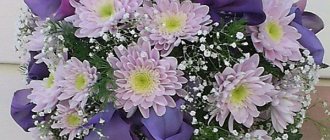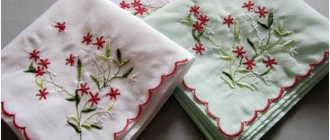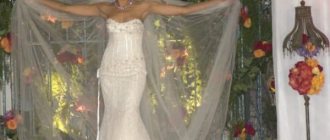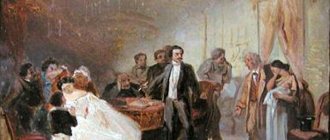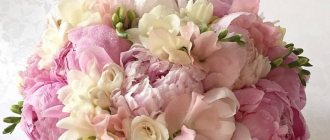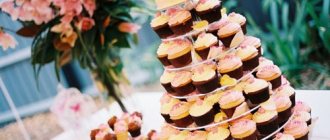Wedding in India - like in the movies? No, this is Indian cinema - almost like a wedding!
Look into those eyes and maybe you will understand why Indian grooms save themselves for the one and only. She's beautiful!
What kind of guy is there, an adult and mature man of about 34 years old, saving himself for his one and only. Don't believe me? Is it true. You say: well, why such details, we are not Indians, we just want to make a stylized wedding evening. So here it is; the wedding will not be completely “Indian”, no matter how luxurious the surroundings are, until you are imbued with a special spirit of chastity, the joy of finding each other and faith in an endless happy future. In India, you see, there is no other scenario: divorces are very, very rare. It is not customary to exchange an old wife for a young beauty.
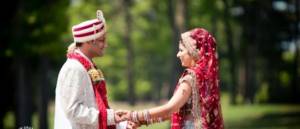
An Indian wedding is a celebration of a lifetime!
An Indian wedding is a grandiose celebration, a coveted moment that is anxiously awaited for decades (until the money is collected, and until the bride is wooed). They prepare seriously for the first night, guests are invited - half of Mumbai! Before choosing flowers, decorations and setting tables, be imbued with this exciting anticipation of the unity of flesh and spirit for the rest of your life. Ready? Well, then let’s start the wedding “Indian style.”
A little history of the creation of Indian wedding dresses
There is a legend that many years ago, while dreaming of his beloved, a young weaver himself did not notice how he wove a very long and beautiful fabric, from which the national Indian outfit - the sari - appeared. Even in modern times, the production of this masterpiece of weaving art in India is mainly done by men. They are the ones who manage to come up with the most perfect combination of bright colors and beautiful patterns.
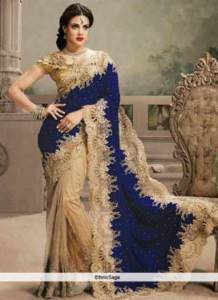
Wedding traditions in each of the many regions of India have their own differences in the design and ways of wearing the saree. But one thing remains unchanged: the sari is the most common type of national women's clothing in India. In addition to the sari, there are several other types of wedding dresses in Indian culture - salwar kameez and lehenga or ghagra choli. A more detailed description of Indian wedding dresses can be found below.
We write wedding invitations in Indian style
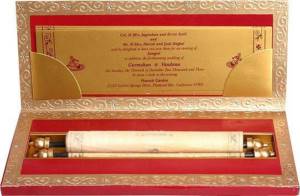
Such a luxurious invitation is difficult to send to all guests; but the most expensive ones - why not?
You can make your wedding invitation traditional; the only reminder of the color will be the design. Thick, satin paper, floral patterns in gold, red, rich green and dark blue are welcome. The more gold the better. In India, especially honored guests are sent invitations on silk scrolls in special boxes. You can put the postcard in a special cardboard box or a thick cardboard envelope - this will also be very Indian.

Doesn't it look wonderful? Such invitations are pleasant to send and pleasant to receive. It is immediately clear what kind of wedding you are invited to and what you should give.
But if you want to maintain the style 100%, then you need to use invitations also as a reminder, a warning: dear guests, the wedding will not be just any wedding, but an Indian one. Come in a sari and give elephants to the newlyweds. Everything will be like in Bollywood!
Sari – the eternal magic of femininity
A sari is a piece of fabric up to 9 meters long. It must be wrapped in several layers around the waist, and the remaining end is thrown over the chest to the shoulder. Indian girls learn the art of wearing and tying a saree from an early age, since it is quite difficult to do this without unnecessary twisting and folding of the fabric. It is also necessary to wear a blouse (choli) with short sleeves with the sari.
A wedding sari is made from thin lightweight fabrics such as:
- organza;
- natural silk;
- chiffon;
Various national ornaments, images of flowers and animals are used to decorate the sari. The edge of the fabric is decorated with rich embroidery made with gold threads, and beads, precious stones, and seed beads are also used to decorate the dress.
The traditional wedding color in India is red, it is a symbol of love and happiness. And also the presence of golden color is required, which means a rich and prosperous life. Also, when making a wedding dress, it is allowed to use colors such as green, blue, pink. But white and black colors have always been forbidden to be used in the manufacture of festive dresses; in India they are a symbol of mourning and grief.
KNOWLEDGE BASE: Italian style wedding dresses - what are they?
The groom's turban and the bride's dress, red as a pomegranate flower...
The next important point is the outfits of the newlyweds.
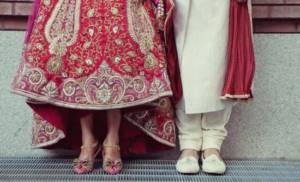
Purple and gold are the main colors for the bride and groom at an Indian wedding.
What you should pay special attention to is the groom's suit. His outfit is no less beautiful than the bride’s!
A gold-embroidered kurta-paijama suit (similar to a prince's camisole) and a turban are very, very masculine, beautiful and... sexy.
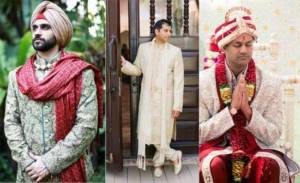
The traditional costume of the Indian groom is in no way inferior to the wedding dress of the bride!
The traditional color of a wedding sari is bright red. For a sari, take a piece of fabric 5-9 meters, in one piece. They are wrapped in a special way: first, like a skirt, they wrap around the hips (starting from the left side), then the remaining end is pinned on the left shoulder.
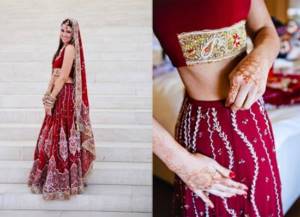
Wearing an Indian wedding sari is not just about zipping up the skirt.
The main secret of the sari is the folds; you need to model them yourself during the “wrapping” process.
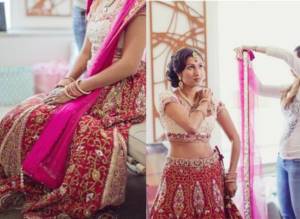
The process of dressing in an Indian sari is the whole art of folding fabulous fabric...
Under the sari, a short blouse like a T-shirt and a lehnga underskirt are worn.
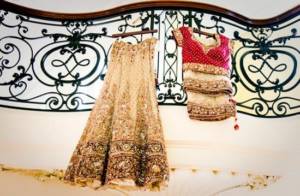
Traditional wedding attire of Indian bride in gold.
But... our wedding is still “in style.” Therefore, it is possible to deviate from traditions. And from the scarlet sari.
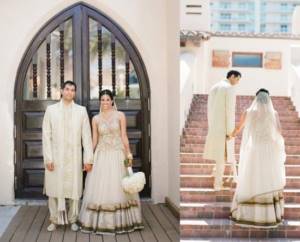
Sometimes Indian brides themselves abandon the red wedding sari in favor of a white dress with a veil...
Even if the bride is not wearing a sari, she needs a cummerbund belt (gold or silver, very elegant). Traditionally it is worn on the hips, but if the style of the dress requires it, it can also be worn on the waist.
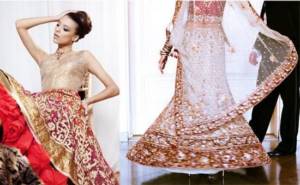
But any other color of a wedding sari is in no way inferior in colorfulness to traditional red!
What should definitely be present in the outfit is an abundance of gold and jewelry: a “tika” pendant on the forehead, a haar necklace on the neck, and karn phool earrings on the ears.
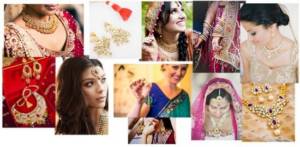
A bride's wedding look would not be complete without luxurious Indian jewelry!
Don’t forget to wear bracelets: above the elbow – bajubankh, on the wrists – red chudiyan. And I soldered many, many silver bracelets with bells on my ankles.
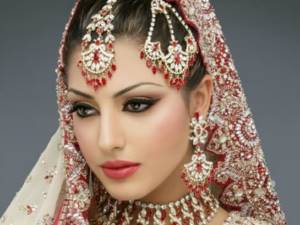
It’s amazing how they do it: they put on a lot of makeup, but nothing tasteless or provocative! And tika, haar and karn phool are amazingly good! Perhaps it's all about amazing harmony and strict adherence to style?
Makeup should be brighter than usual wedding makeup: kajal or anjana eyeliner is applied to the eyes. The lips are painted so that they look plump and soft, and the eyebrows are dark and clearly defined, hair to hair.
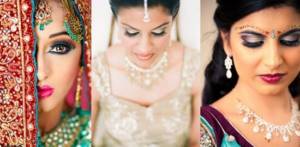
But in general, wedding makeup should be in harmony with the bride’s wedding image.
Yes, a nose ring with a chain to the ear is also a must for an Indian bride. True, before deciding on such an exotic, you should think carefully.
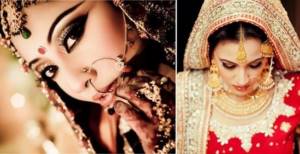
Not every bride dares to achieve such beauty...
The bride's bouquet is always red, and only red! These could be purple roses, scarlet carnations or crimson orchids. White flowers in the hair (wedding braid) and just garlands on the shoulders and neck are also required...
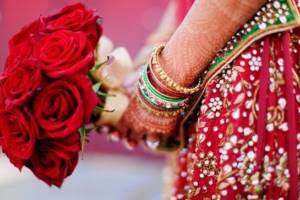
Red color in Indian culture is the color of good luck and happiness, prosperity. Therefore, the bride can only have red flowers in her hands.
Guests' outfits will help create the ambience of an Indian wedding
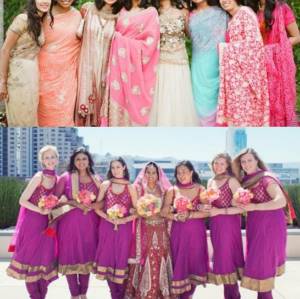
Offer colorful traditional sarees for your girlfriends at your wedding!
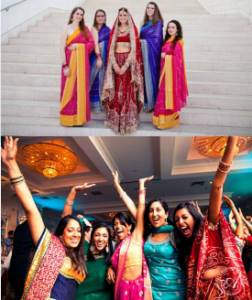
Bridesmaids will be delighted at the prospect of wearing exotic Indian silks.
Salwar kameez
Wedding attire in the Indian style, salwar kameez, consists of narrow or, on the contrary, loose pants, a dress in the form of a tunic and a dupatta. The dress has a length slightly below the hips and slits on the sides. A dupatta is a transparent, lightweight cape. The bride in this wedding dress will feel very comfortable and free. The indispensable attributes of festive attire are, of course, rich decorations in the form of gold embroidery and jewelry.
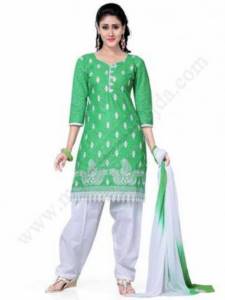
The secret of mehendi and the image of the bride at an Indian wedding
According to tradition in India, on the eve of the wedding, the bride gets mehendi - a henna tattoo. We need to make a clarification: the groom also gets mehendi done. And this is a very important point. It is believed that the more drawings are applied, the richer the openwork ornament, the happier the life awaits the newlyweds.
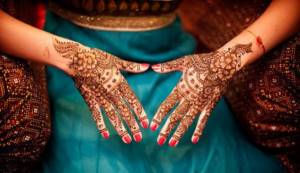
Perhaps the harmony of future relationships is programmed in the exquisite lines of the mehendi pattern?
Henna has healing and cleansing properties and special energy. Typically, mehendi is applied to the palms and arms up to the elbow (something like painted gloves), feet and ankles. Why palms? – This is probably not accidental; Fate draws its lines on the palms; here is the reflection of all seven chakras. The same can be said about the feet.
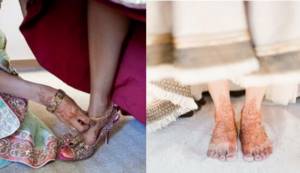
Henna designs cover not only the hands of an Indian bride, but also her feet.
Mehendi relaxes and promotes relaxation; the procedure takes almost the whole day. Do you know what bridesmaids and bridesmaids talk about all this time in India? – About sex; about the first wedding night; about the secrets of a happy marriage. All the remaining henna is “painted” on friends; everyone should have enough happiness on this day!
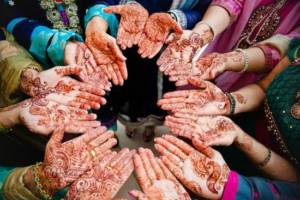
There should be plenty of happiness for all the bridesmaids on this day!
Previously (and in some Indian nations even now) a small white spot was left in the center of the palm; It was these white circles that connected the bride and groom during the marriage ceremony. What is happening at this moment? – Energy exchange, invisible energy bonds arise? Maybe the secret to the longevity and strength of Indian marriages lies in this tattoo? Who knows who knows. You decide.
Interesting customs of India
Interestingly, in India, it is the parents of the future groom who choose a wife for their son. If the girl is worthy and her parents give their consent, a wedding date is set. But at the same time, a compatibility horoscope must be drawn up for future newlyweds.
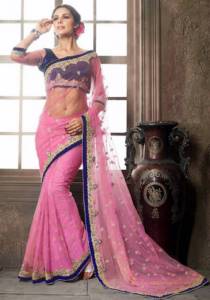
Sari - the cultural heritage of India
Marriages are commonly considered “arranged weddings” because essentially the parents decide everything. The groom's parents handle the wedding planning, and all wedding expenses are paid by the bride's parents. Outfits for marriage ceremonies, a wedding sari for the bride and a Shirvani frock coat with narrow churidar pants, are purchased by future newlyweds on their own
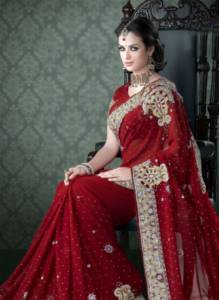
Each flower and ornament is embroidered by hand. Amazing!
The ceremony takes place at the bride's house. Often the wedding celebration is celebrated from several days to several weeks. After the holiday, the bride moves into the groom's house and becomes a faithful companion and helper for her husband.
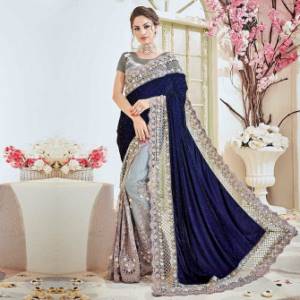
Dark blue and silver embroidery look elegant, noble, expensive
Behind the bride on a white horse
Finally, the age-old girl's dream of all times and peoples has come true! The groom should arrive on a white horse decorated with red and yellow flowers. Accompanied by a witness with a red and yellow umbrella. What? Is there a stable nearby? Can't be. Then you will have to get to the bride on an elephant. And there is no elephant? But there will definitely be at least one white Mercedes in the area!
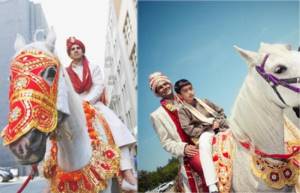
What bride doesn't dream of a groom on a white horse?
Of course, if the betrothed in a turban and camisole, like a real Indian newlywed, arrives on a snow-white pacer with a luxurious mane, it will be unforgettable. And very beautiful. But the best option (in order not to expose your loved one to danger) is to choose a light carriage drawn by a white horse.
Keep in mind that no matter what you choose: a horse, a carriage or a white car, yellow and red flowers are required for decoration.
Photos of modern wedding saris in India
No matter how ancient a tradition the sari is considered, to this day it looks majestic and feminine on a girl. The image is complemented not only by jewelry throughout the body, but also by a braid into which fresh flowers are woven. Over time, European brides complemented the look with neatly tied up or loose hair. Nowadays, the lifestyle, character, ambitions, and aspirations of an Indian bride can be read from her outfit alone. Use the photo selection below to choose an outfit for yourself.
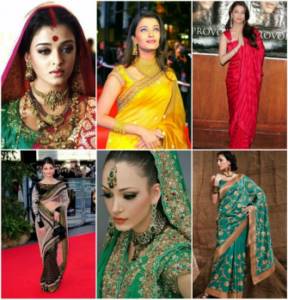
Banquet hall design: two vacuum cleaners, one round platform and a bunch of petals
Yes, you need to get all this. And a couple more chairs that look like thrones (for the bride and groom in the banquet hall). When young people arrive at the restaurant after the registry office, they must climb onto a high, round, rotating platform. And so, imagine: the stand rotates, music from Indian films thunders, the newlyweds exchange garlands of flowers and take an oath of allegiance. Since the structure rotates, everything is clearly visible to all guests. Bollywood is real! But that's not all.
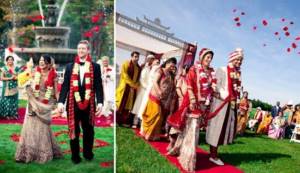
A beautiful ritual of showering rose petals in an Indian wedding ceremony.
In India, there are probably special devices, they work like this: the wind blows on the young with (fresh) flower petals. In our conditions, it is possible to try vacuum cleaners. It is better to try the system in advance.
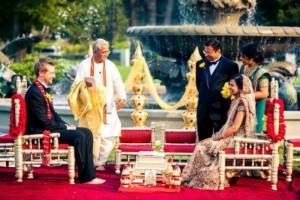
Wedding ceremony in bright traditional colors.
After exchanging garlands of vows, the newlyweds leave the “carousel” and sit in luxurious armchairs. Guests and relatives come up, give gifts and wish you happiness and prosperity. But you can come up with something else of your own: for example, shoot a video in advance in the style of Raj Kapoor about the meeting and love of the newlyweds. Poignant and romantic. In India, it seems they haven’t thought of this yet.
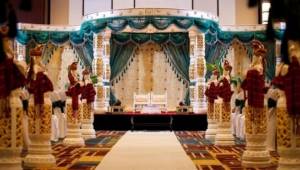
A special wedding arch is arranged for the bride and groom, where luxurious, royal chairs are installed: yes, they should reign at their celebration.
The decoration of the banquet hall is dominated by red and yellow tones; there should be a lot of flowers. Usually these are orchids, carnations, small roses and lilies. Garlands are woven from them, and artificial ones are used along with fresh flowers for durability.
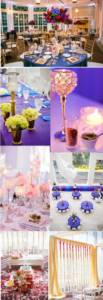
How can you decorate a wedding hall in Indian style?
Indian newlyweds: image of the bride and groom
Not only the traditions and customs of Indian weddings amaze with their beauty, but also the newlyweds, who look bright and impressive at the celebration, because this day is considered one of the happiest in their lives. What Indian brides usually look like:
- The bride is wearing a fiery sari embroidered with gold threads.
- Hands and feet are painted with henna.
- An obligatory attribute of a woman's image is Indian wedding jewelry, in particular, traditional red bracelets, which “say” that the girl is getting married. There is a gold ring in the left nostril.
- The bride's hair is generously lubricated with aromatic oils and braided. The parting is decorated with fresh flowers and/or precious stones.
- A red dot (tilak) is always drawn on the forehead, and the eyebrows are decorated with gold beads.
Next to such a spectacular bride, the groom should look the part:
- On his wedding day, he wears tight trousers and a wide dress, belted with a bright red sash. His outfit is richly embroidered with gold, like the bride's wedding dress.
- The groom puts a bright turban on his head.
- A red dot is also drawn on his forehead, which is applied to him by the bride’s mother when the young man arrives at their home.
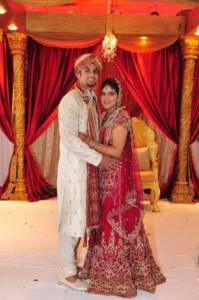
If you decide to organize a wedding in a national style based on the beautiful eastern country of India, then these are the images you will have to create together with the groom!
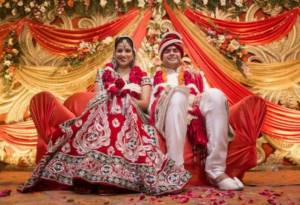
Oriental, Chinese, Indian wedding dresses - bright outfits for brides
Modern brides are the heroines of weddings taking place in the most seemingly unexpected styles. One of the most popular today is the oriental style, which requires an outfit created in Indian, Chinese or oriental traditions to maintain.
Themed weddings are colorful celebrations, rich in color and many different nuances that highlight the features of the chosen style. One of the most important heroes of such a celebration is the bride. Indian wedding dresses help create her image and make the holiday even more colorful and rich.
Oriental style wedding dress – review
Along with the well-known wedding dresses of European masters, oriental-style outfits remain attractive and even a little mysterious. They seem to attract brides from different countries, enchanting with their beauty and chic.
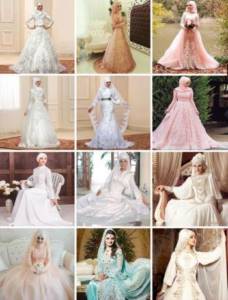
Despite the fact that in such dresses there are no bare shoulders, the hair of the young beauty is always hidden, and often her face, the image of a Muslim bride can be compared to the image of a fairy-tale princess. Arabic wedding dresses are among the richest and most complex. To create such an outfit you need a huge amount of:
- precious and semi-precious stones;
- natural pearls (in rare cases, artificial pearls are used);
- beads;
- embroidery done on very expensive fabric.
The peculiarity of the costume is a large amount of fabric, both light, almost weightless, and satin or silk. The hair, neck, and hands of a young girl must be hidden from prying eyes.
The color of the dress is not always white (a symbol of innocence and purity among European peoples). An oriental wedding suit is sewn using fabric that symbolizes wealth, happiness, health, and longevity.
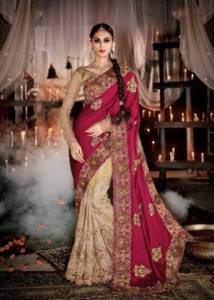
That is why wedding dresses in oriental style can be:
Expensive jewelry is considered a mandatory accessory. These are not only earrings and rings, this is a belt, a tiara - a kind of crown on the beauty’s head. Embroidery on a wedding dress in oriental style is a national ornament, complemented by rhinestones, glass beads, and, if possible, natural precious stones. The style is chosen in such a way as to emphasize all the advantages of the bride’s figure: her proud posture, thin waist.
Despite the fact that the traditional Arabic wedding dress resembles a robe, it is decorated in such a way that there is no shadow of doubt about the solemnity of the moment for which it was created and put on the girl.
